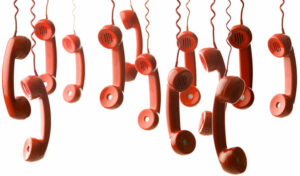In this article we define what is meant by a lost call, look at the types of lost call contact centres face, and outline ways to track and reduce lost calls.
What Is a Lost Call?
Contact centre lost calls can simply be defined as any inbound calls that do not result in the caller being connected to an advisor.
This happens when the customer hangs up (abandons) or is disconnected by the centre. The centre may disconnect a call deliberately, because of timeout – the call was taking too long in a queue to reach an agent – or through error.
Types of Lost Call in a Contact Centre
Generally speaking, there are three types of lost call that can happen in a contact centre that leaders need to be aware of:
- Abandoned – The customer ends the call before it is answered. The industry standard suggests that an abandon rate of 2–5% is commonplace.
- Missed – The call is deliberately disconnected by the centre. This usually occurs when an incoming call reaches the maximum threshold for waiting time set by the ACD.
- Dropped – The call is accidentally disconnected due to a technical error. The dropped call rate for landline calls is below 0.01%. The rate for mobile phone calls is slightly higher, but a dropped call rate of even a few percent would warrant further investigation.
Why Lost Calls Matter
In a contact centre, lost calls matter because of the negative impact they can have on both the contact centre and the customer.
To put it another way, every lost call is a missed opportunity to generate revenue and increase customer satisfaction (C-SAT).
There are three main reasons why lost calls matter in a contact centre:
1. Poor Customer Service
Lost calls can have a hugely negative impact on the quality of the customer service the contact centre is providing.
Unanswered calls, long wait times, poor routing, all impact the customer experience and lead to dissatisfaction.
Unanswered calls, long wait times, poor routing, all impact the customer experience and lead to dissatisfaction.
Maybe customers can overlook it on one occasion, depending on the situation, but a poor experience can lead to customers taking their business elsewhere.
2. Ongoing Costs to the Business
Not only can lost calls lead to lost customers, businesses can face other costs too. The contact centre could also face compliance fines or legal issues, on top of the actual cost to handle any incoming call, whether it connects or not, and the failure to address that customer’s needs.
3. Reputational Damage and Lost Business
If you think that once a call is lost that’s the end of it, then you are wrong. The ongoing damage to contact centres caused by lost calls can be hugely damaging.
In the short term, contact centres could face the loss of customers, but this is coupled with reputational damage, especially if lost calls are a common occurrence.
Customers who have a negative experience with a business could leave negative reviews, submit complaints and head to social media to air their grievances – all of which can make it harder for businesses to get new customers in the future, especially if they don’t make changes.
Seven Reasons Contact Centres Face Lost Calls
Understanding what a lost call is, and why a lost call matters in a contact centre, is the first step to addressing any issues. But before you can make any changes, you need to know what is causing your lost calls.
Calls can be lost for a number of reasons, including:
Customer Frustration
Customer frustration is linked to abandonment, as if the customer becomes unhappy due to their experience, they may choose to hang up the call out of sheer frustration.
Mismanagement
If you don’t have the right systems and people in place to handle calls, this can lead to lost calls.
For example, staffing shortages, skills deficits, or poorly designed systems and processes all contribute to lost calls.
If you don’t have the right systems and people in place to handle calls, this can lead to lost calls.
Technical Issues
A lost call can also be caused by technical issues. Equipment malfunctions and system issues can lead to lost calls, and some issues could even effect call routing and connection.
System Overload
Should contact volumes spike, contact centre systems could become overloaded and contribute to calls being lost.
Abandonment
A caller hanging up and abandoning the call is one of the most common reasons for lost calls. There are many reasons why a caller may decide to end the call before speaking to the company, for example waiting on hold for a long time, and ineffective IVR systems.
If you are looking to calculate your call abandon rate, read our article: How to Measure Call Abandon Rate
Overflow
An unexpected increase in call volumes can lead to lost calls as the call routing system can become overloaded and may not be able to direct calls to available agents.
Agent Availability
Quite simply, if there are not enough agents to handle incoming call volumes then calls can go unanswered, leading to lost calls.
How to Track Lost Calls
By combining proactive monitoring with data analysis, contact centres can track lost calls.
For example, lost calls are generally detected, recorded and tracked within the ACD system. This is useful data for forecasting and scheduling, so it is important that you make sure that the ACD system’s definition matches the contact centre’s.
You should note that this is not the only way to track and evaluate lost calls. There are other systems and processes your contact centre can implement to maximize their visibility:
Track and Record Calls
The software used by the contact centre should record all incoming calls. As this should include lost calls, contact centres can check the information to identify and analyse information relating to the call including the date, time, duration, and even the reason the call was lost.
As part of this, contact centres should ensure that the reasons for the lost call are clearly defined and grouped into categories such as abandonment, technical issue, agents unavailable, etc.
Implement Call Analytics and Reporting
Using software to analyse and report on lost calls and their associated reasons will allow contact centres to identify and visualize any patterns and trends.
Contact centres should also look to their SLAs and track the recorded call metrics against these to identify if the number of lost calls increases if these targets have not been met.
For example, look at abandoned calls to see if the number increases or decreases based on date and time, or even queue length.
Contact centres should also look to their SLAs and track the recorded call metrics against these to identify if the number of lost calls increases if these targets have not been met.
Monitor Calls in Real Time
Although looking at historical data can be beneficial to contact centres looking to develop their strategies and processes, if managers can’t take immediate action in the event of an issue or spike in contact volumes, then there can be issues.
Using dashboards that show call metrics in real time, such as queue length, wait times, and call volumes, for example, will enable managers to reallocate resource and take action immediately.
Contact centres can even take it a step further and get their systems to send alerts and notifications when set lost call or even queue parameters are met.
Call Routing and IVRs
Having a streamlined, clear and helpful IVR and call routing system can also help with tracking lost calls.
Knowing the customer journey and pinpointing when calls drop off can be extremely useful, as complex IVR menus, poorly planned customer journeys, and misrouted calls all lead to increased lost calls.
Get Customer Feedback
Potentially one of the most useful tools at the contact centre’s disposal is customer feedback. This could be surveys, reviews, or even complaints. Regardless of how it comes into the contact centre, this information can provide valuable insights on lost calls and the reasons behind them.
For advice on where to get customer feedback, read our article: 5 Places to Source Great Customer Feedback
How to Reduce Lost Calls in the Contact Centre
With the infrastructure in place to track lost calls, the next step is reducing them as much as possible, and there are several ways contact centres can do this, including:
Improve Staffing
Easy to say, difficult to do. But by building better forecasts and schedules, contact centres can more accurately meet incoming demand and avoid customers hanging up.
Reduce Queue Times
Queuing times can be brought down by making more agents available to take calls. Employing new agents is expensive, but upskilling existing agents to handle both inbound and outbound calls keeps staff on site without reducing occupancy in low-traffic periods.
A virtual queuing mechanism allows customers to hold their place in the queue of inbound customers without needing to stay on the line.
Virtual queuing is a compelling method for reducing the rate at which calls are cut off, while usually contributing to overall customer satisfaction (C-SAT). The virtual queuing mechanism allows customers to hold their place in the queue of inbound customers without needing to stay on the line.
Instead, their position in the queue is logged, and when they reach the front, the contact centre places an outbound call to them. This impacts lost call rates because the line cannot time out over a lengthy period of hold, and the customer cannot abandon the call.
Offer Callbacks
With calling line identity (also known as Caller ID or CLI) you can identify in the system any telephone numbers that have abandoned. These numbers can then be loaded into an outbound dialler to call the customer back.
Bolster On-Hold Messaging and Music

What customers hear while queuing can also contribute quite seriously to call abandonment rates. Low-quality recordings, short loops of music and messages that repeat too frequently are all factors known to drive customers away.
Present on-hold messages in order of importance to the customer. The more important the message, the more it will keep the customer engaged. Not-so-important messages will include those that involve cross-selling.
Understanding the demographic of customers and choosing hold music that’s suited to them will likely encourage customers to stay on the line longer.
Now, if customers are only waiting 20 seconds, this may not be the best course of action, as it increases customer effort. But for longer queues, this could help to reduce call abandons.
Grab a few more pearls of wisdom on this topic by reading our article: What Customers Really Think of Music on Hold
Streamline the IVR
If you simplify the IVR, customers will likely have more patience when they enter the queue. This will stop them from abandoning early and also greatly reduce frustration.
Check Advisors’ Internet Speeds
Dropped calls are often a result of network connectivity problems. Dropped calls are more common when working in a remote contact centre environment.
So, run internet speed checks with work-from-home (WFM) advisors. Also, offer them Wi-Fi boosters to increase speeds, and build a requirement for good internet into the contact centre’s homeworking policy.
Plot a Call Abandon Curve
Plotting a ‘call abandon curve’ – a graphed average of when callers hang up – can identify common factors that lead to abandoned calls and suggest potential changes to prevent them.
Here’s an example of one customer abandon curve:

For example, it’s common to see calls abandoned at the point an IVR requests information from the customer that they do not have to hand.
Similarly, customers may leave a call when alternative contact options are listed, such as email or social media. When dissecting this information, it is standard practice to discount calls that last less than 5 seconds, on the assumption that these are due to customer error.
If you are looking for more information on lost calls, you should read our article: What Is the Difference Between an Abandoned, a Missed and a Lost Call?
Author: Robyn Coppell
Reviewed by: Jonty Pearce
Published On: 9th Oct 2023 - Last modified: 9th Nov 2023
Read more about - Technology, Abandoned Calls, Average Speed of Answer (ASA), Call Routing, CX





















